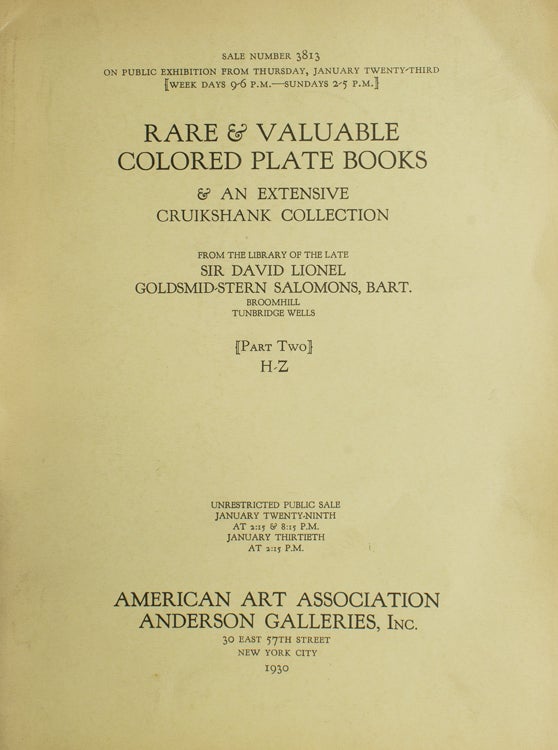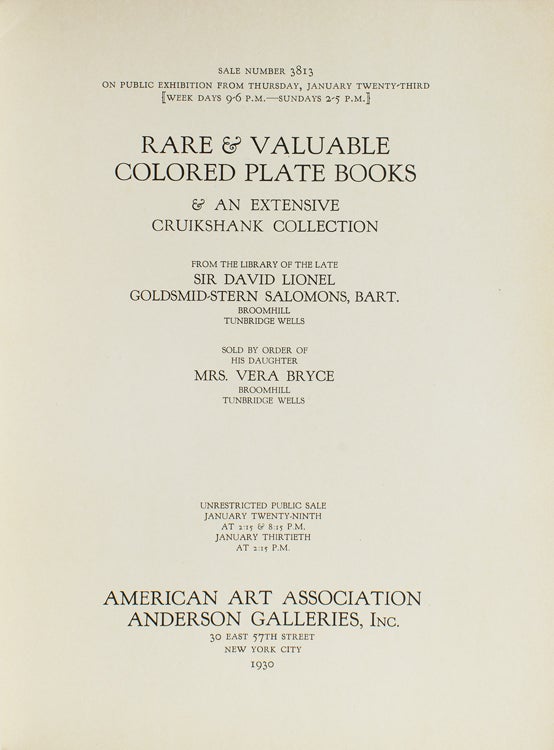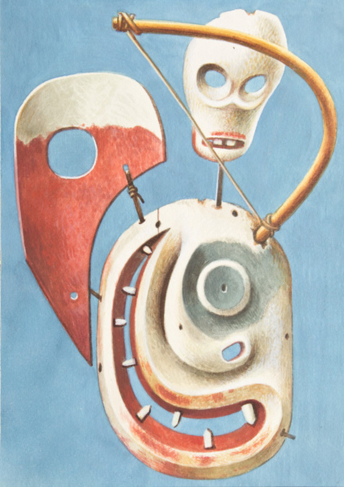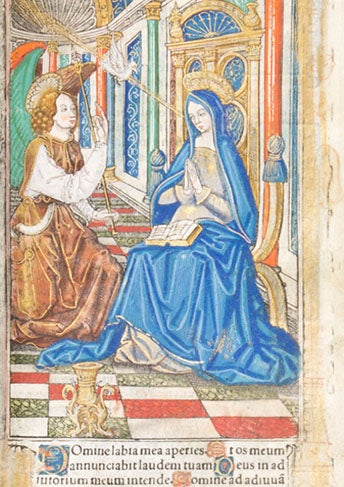Rare & Valuable Colored Plate Books. from the Library of the Late Sir David Lionel Goldsmid-Stern Salomons, Bart, Broomhill Tunbridge Wells sold by the order of His Daughtere Mrs. Vera Bryce Broomhill, Tunbridge Wells.
London: American Art Association Anderson Galleries, 1930.
Price: $100.00
About the item
2 vols. 4to. Printed wrappers. Fine.
Item #229034
Salomons, Sir David Lionel Goldsmid-Stern-, second baronet (1851-1925), mechanic, was born on 28 June 1851, at 18 Brunswick Terrace, Hove, Sussex, only son of Philip Salomons (1796-1867), gentleman-at-arms, and his wife, Emma Abigail (1830-1859), daughter of Jacob Montefiore, merchant of Sydney, New South Wales. He had two younger sisters. He was educated privately at Brighton, and attended University College, London, before reading the natural science tripos at Gonville and Caius College, Cambridge (BA 1873). In 1873 he succeeded by special remainder (dated 1869) his uncle, Sir David Salomons, as second baronet, and inherited the Broomhill estate near Tunbridge Wells. In 1874 he was called to the bar at the Middle Temple and was unsuccessful Liberal parliamentary candidate for Mid Kent. He contested St George-in-the-East as a Liberal in 1885, but seceded from that party in 1910 and was a convinced tariff reformer by 1912. He was active in Kentish affairs, as a magistrate (1874), high sheriff (1881), and mayor of Tunbridge Wells (1895), and serving for fifteen years on the county council. He succeeded another Kentish landowner, Lord Brabourne, on the board of the South Eastern and Chatham Railway (1895), and was a director of its successor, Southern Railway (1922). Salomons's life was, however, notable less for his public and official services than for the distinction of his private avocations. From the earliest age Salomons played with clockwork engines, building blocks, and tools. In adolescence he wandered around Clerkenwell and Soho looking into tool shops. At the age of fourteen he befriended a working watchmaker who taught him practical mechanics: he retained a lifelong interest in watchmaking, became a member of the Clockmakers' Company, and published a monograph in 1921 on the French watchmaker Breguet, of whose work he amassed a large collection. After his succession to the baronetcy he installed private workshops, laboratories, and electricity at Broomhill in 1874, and investigated electromotive force and electric conductors in association with Sir Charles Wheatstone. In 1876 he built a waterworks at Broomhill and fitted a telescope to its water-tower. Within a few years he had thousands of tools in his workshop and was constantly devising experiments. He took out patents for railway signalling, electric lamps, current meters, electric circuits, electric magnets, pressure gauges, vacuum tubes, electric torches, and electromotor apparatus. He was one of the founders of the Institution of Electrical Engineers, serving as vice-president and treasurer, but, as a non-professional electrical engineer, he was judged ineligible for its presidency. His textbook, Electric Light Installations, passed through eleven editions during the 1880s and 1890s. Salomons was first chairman of the City of London Electric Lighting Company established in 1891 with an electric-lighting franchise for the City of London and the St Saviour's district of Southwark. As well as his lifelong delight in gadgetry Salomons enjoyed tandem and four-in-hand driving. In 1874 he built a tricycle powered by a 2 hp electric motor, and later imported from France the second petrol-driven car to appear in England. He organized trial demonstrations of early automobiles from 1895 (Lord Salisbury was nervous on a joyride with Salomons at Crystal Palace), and as president of the Self-Propelled Traffic Association was instrumental in removing the legal restrictions which until 1896 compelled horseless carriages to be preceded by a man waving a red flag. Salomons was a founder of the Royal Automobile Club and wrote pamphlets, articles, and lectures on motor cars, including a chapter 'The motor stable and its management' in the volume on motoring edited by Lord Northcliffe for the Badminton Library series. He later developed a comparable interest in aviation. Salomons had a practical as well as theoretical interest in radium, and made donations of radium and radioactive equipment to several hospitals. He gave monetary or other endowments both to Cambridge colleges and to learned societies. He served on the jury of the Universal Exhibition at Paris in 1900 and donated the pavilion to exhibit contemporary British art at the Venice Exhibition of 1909. The versatility of Salomons's interests is attested to by the many learned societies that honoured him. He was a fellow of the Royal Astronomical, Chemical, and Geological societies and of the Physical Society of London. He was a gold medallist of the Royal Photographic Society, an associate member of the Institution of Civil Engineers, an honorary member of the International Society of Electricians, president of the Society of Engineers (1901), and honorary colonel of the Kent (fortress) Royal Engineers. He was master of the Coopers' Company in 1893. His sponsors for the Athenaeum in 1901 were Lord Alverstone, Lord Avebury, A. J. Balfour, Joseph Chamberlain, and Lord James of Hereford. Salomons married in 1882 Laura Julia (1855-1935), younger daughter of Hermann de Stern, a London banker and Portuguese baron, and sister of the first Baron Michelham. He assumed by royal licence the surname of Goldsmid-Stern-Salomons in 1899. He had one son (Reginald, who died at Gallipoli) and four daughters. He died after an operation on 19 April 1925, in a nursing home at 4 Dorset Square, St Marylebone, and was buried in his family's private chapel ground at Lower Green, Tunbridge Wells. His baronetcy became extinct. His will included bequests to Gonville and Caius College, to Cambridge University, and to the Bibliothèque Nationale in Paris Wealth at death £388,412 19s. 6d.: probate, 19 June 1925, CGPLA Eng. & Wales.





